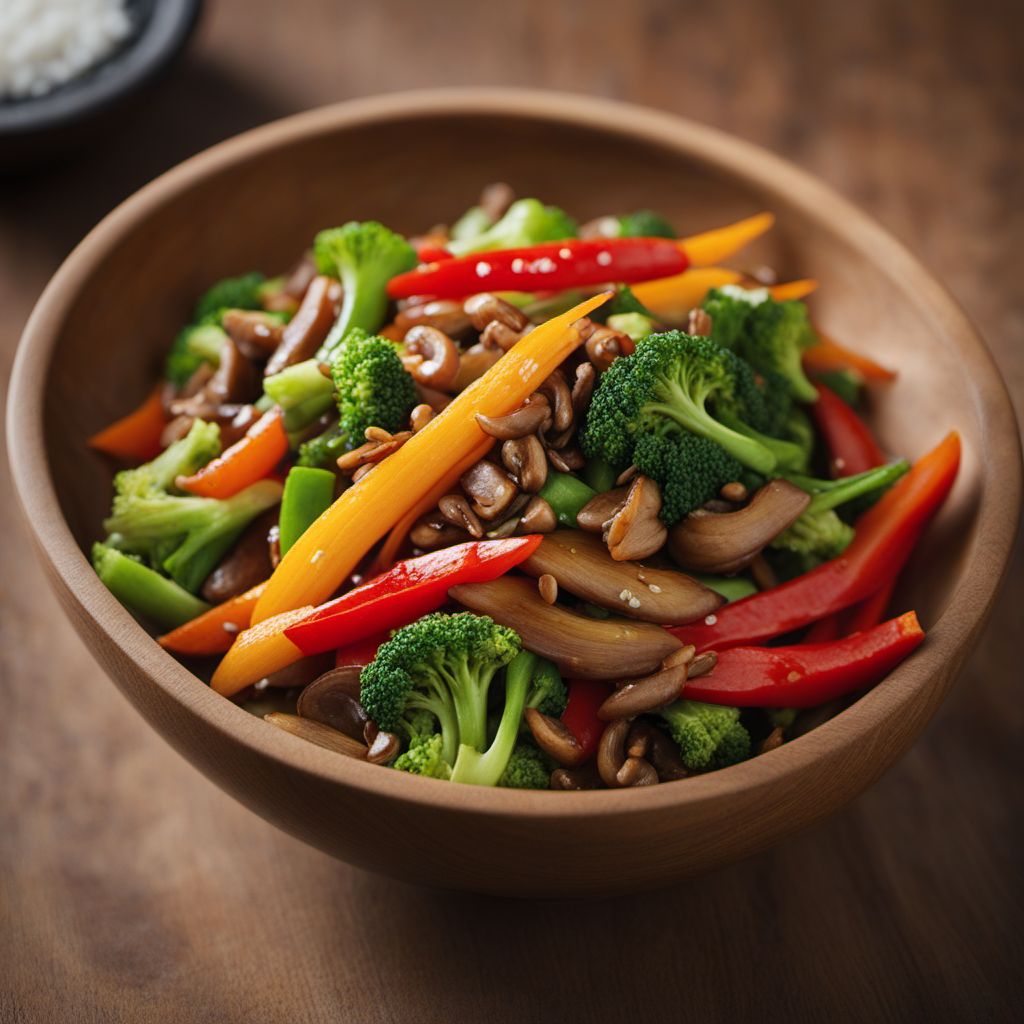
Recipe
Chinese Buddhist-Style Vegetable Stir-Fry
Zen Garden Stir-Fry: A Harmony of Flavors and Textures
4.7 out of 5
In Chinese Buddhist cuisine, simplicity and balance are key. This recipe for Chinese Buddhist-Style Vegetable Stir-Fry captures the essence of this cuisine by combining fresh, seasonal vegetables with delicate flavors and minimal seasoning.
Metadata
Preparation time
15 minutes
Cooking time
10 minutes
Total time
25 minutes
Yields
4 servings
Preparation difficulty
Easy
Suitable for
Vegetarian, Vegan, Gluten-free, Dairy-free, Low-calorie
Allergens
Soy
Not suitable for
Paleo, Keto, High-protein, Low-carb, Nut-free
Ingredients
This adaptation of the Bosnian dish, Gunjanski gojtani, to Chinese Buddhist cuisine involves several changes. Firstly, the original dish typically includes meat, which is omitted in the Buddhist version to align with the vegetarian principles of Chinese Buddhist cuisine. Secondly, the original dish uses a variety of spices and seasonings, whereas the Chinese Buddhist version focuses on the natural flavors of the vegetables with minimal seasoning. Lastly, the cooking technique is modified to a stir-fry, which is commonly used in Chinese cuisine. We alse have the original recipe for Gunjanski gojtani, so you can check it out.
-
2 tablespoons (30ml) vegetable oil 2 tablespoons (30ml) vegetable oil
-
1 medium onion, thinly sliced 1 medium onion, thinly sliced
-
2 cloves of garlic, minced 2 cloves of garlic, minced
-
1 red bell pepper, thinly sliced 1 red bell pepper, thinly sliced
-
1 yellow bell pepper, thinly sliced 1 yellow bell pepper, thinly sliced
-
1 medium carrot, julienned 1 medium carrot, julienned
-
1 cup (150g) snow peas, trimmed 1 cup (150g) snow peas, trimmed
-
1 cup (150g) broccoli florets 1 cup (150g) broccoli florets
-
1 cup (150g) mushrooms, sliced 1 cup (150g) mushrooms, sliced
-
1 cup (150g) baby corn, halved lengthwise 1 cup (150g) baby corn, halved lengthwise
-
2 tablespoons (30ml) soy sauce 2 tablespoons (30ml) soy sauce
-
1 tablespoon (15ml) rice vinegar 1 tablespoon (15ml) rice vinegar
-
1 teaspoon (5ml) sesame oil 1 teaspoon (5ml) sesame oil
-
Salt and pepper to taste Salt and pepper to taste
Nutrition
- Calories (kcal / KJ): 150 kcal / 628 KJ
- Fat (total, saturated): 8g, 1g
- Carbohydrates (total, sugars): 16g, 6g
- Protein: 4g
- Fiber: 5g
- Salt: 1g
Preparation
-
1.Heat the vegetable oil in a wok or large skillet over high heat.
-
2.Add the sliced onion and minced garlic to the hot oil and stir-fry for 1-2 minutes until fragrant.
-
3.Add the bell peppers, carrot, snow peas, broccoli, mushrooms, and baby corn to the wok. Stir-fry for 3-4 minutes until the vegetables are crisp-tender.
-
4.In a small bowl, whisk together the soy sauce, rice vinegar, sesame oil, salt, and pepper.
-
5.Pour the sauce over the vegetables in the wok and toss to coat evenly.
-
6.Continue stir-frying for an additional 1-2 minutes until the sauce has thickened slightly and the vegetables are well-coated.
-
7.Remove from heat and serve the Chinese Buddhist-Style Vegetable Stir-Fry hot.
Treat your ingredients with care...
- Mushrooms — Make sure to clean the mushrooms thoroughly and slice them evenly for even cooking.
- Snow peas — Trim the ends of the snow peas and remove any tough strings before adding them to the stir-fry.
- Baby corn — Halve the baby corn lengthwise to ensure they cook evenly and absorb the flavors of the dish.
- Rice vinegar — Use a mild rice vinegar to balance the flavors without overpowering the vegetables.
- Sesame oil — Add the sesame oil towards the end of cooking to preserve its delicate aroma.
Tips & Tricks
- For added protein, you can include tofu or tempeh in the stir-fry.
- Customize the vegetables based on seasonal availability for the freshest flavors.
- Add a sprinkle of toasted sesame seeds or chopped green onions as a garnish for extra flavor and visual appeal.
- If you prefer a spicier stir-fry, add a dash of chili sauce or red pepper flakes.
- Serve the stir-fry over steamed rice or noodles for a complete meal.
Serving advice
Chinese Buddhist-Style Vegetable Stir-Fry is best served hot as a main course. It pairs well with steamed rice or noodles for a satisfying meal. Garnish with toasted sesame seeds or chopped green onions for an extra touch of flavor and presentation.
Presentation advice
To enhance the presentation of the Chinese Buddhist-Style Vegetable Stir-Fry, arrange the colorful vegetables in a circular pattern on a serving platter. Drizzle a little extra sauce over the top and garnish with fresh herbs or edible flowers for an elegant touch.
More recipes...
For Gunjanski gojtani
For Bosnian cuisine » Browse all
For Chinese Buddhist cuisine » Browse all

Chinese Buddhist Tortilla de Rescoldo
Zen-inspired Rescoldo Tortilla: A Chinese Buddhist Twist on a Traditional Argentinian Dish

Crispy Lotus Root Fritters
Golden Lotus Delights: Crispy Fritters with a Chinese Twist

Chinese Buddhist Eddoes Stir-Fry
Zen Eddoes Delight: A Chinese Buddhist Twist on Trinidadian Choka
More Bosnian cuisine dishes » Browse all

Kljukuša
Kljukuša is a traditional Bosnian dish that is made with a cornmeal batter and a savory filling. It is a popular dish in the region of Bosnia and...

Sarajevska čorba
Sarajevo soup
Sarajevska čorba is a traditional Bosnian soup made with beef and vegetables. It is a hearty and flavorful dish that is perfect for cold winter days.

Gradačačka kutija
Gradačac box
Gradačačka kutija is a traditional Bosnian dish that is made with layers of phyllo dough, cheese, and spinach. This savory dish is perfect for a...




